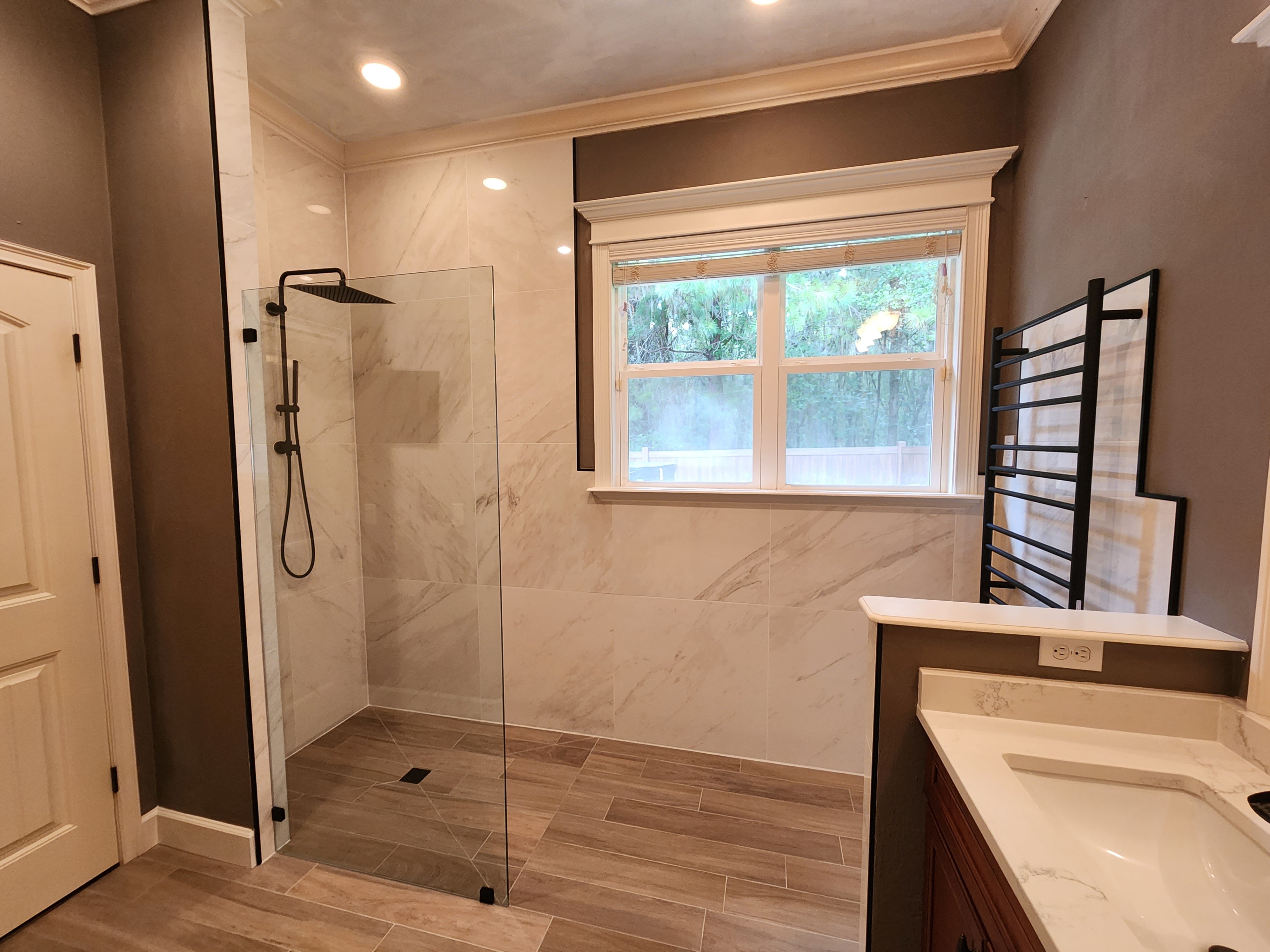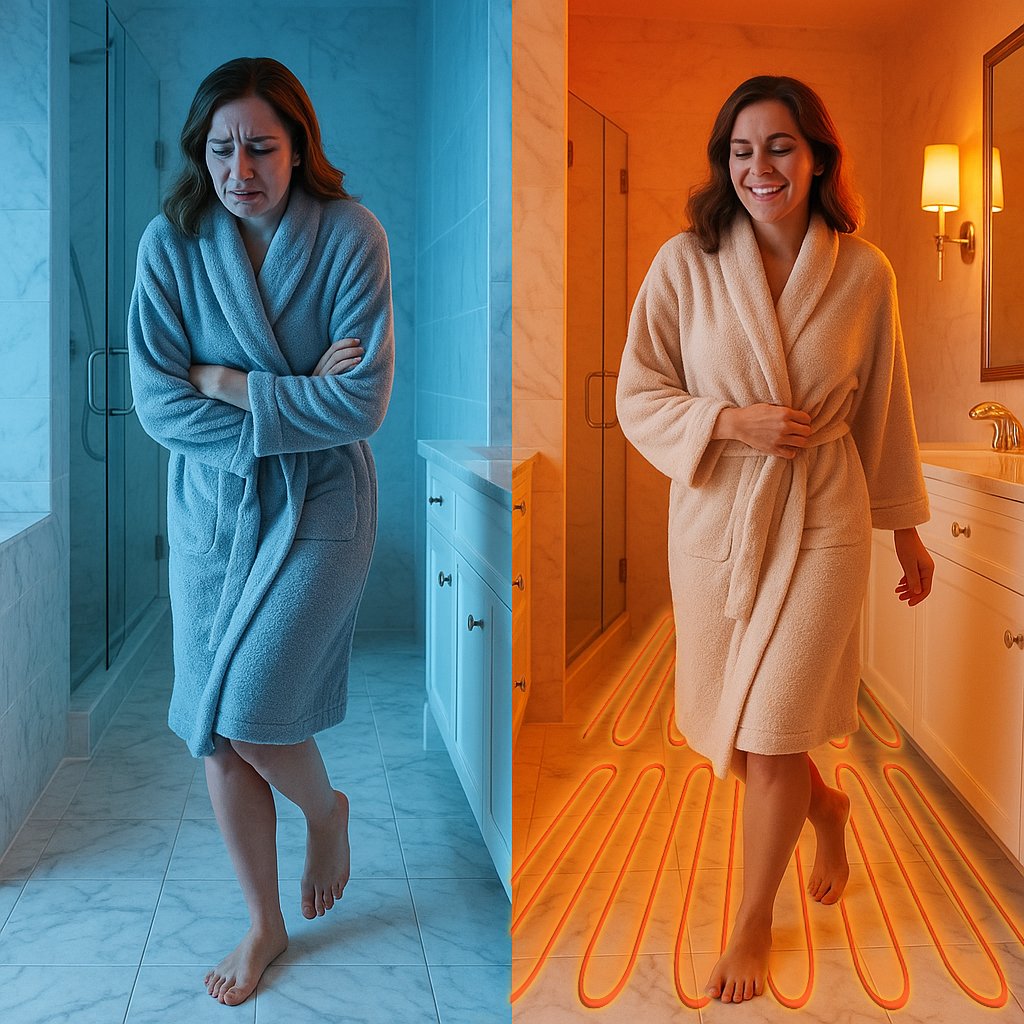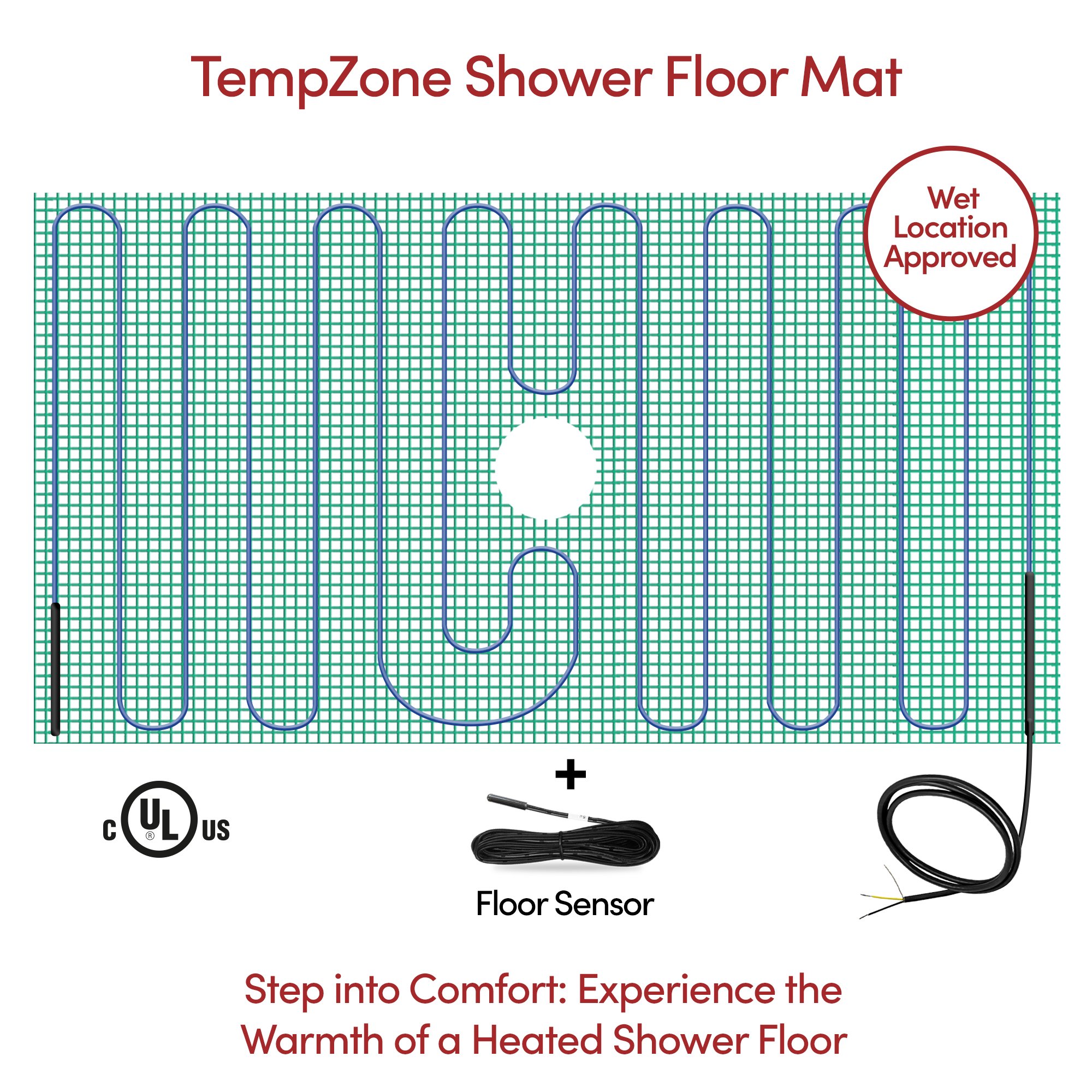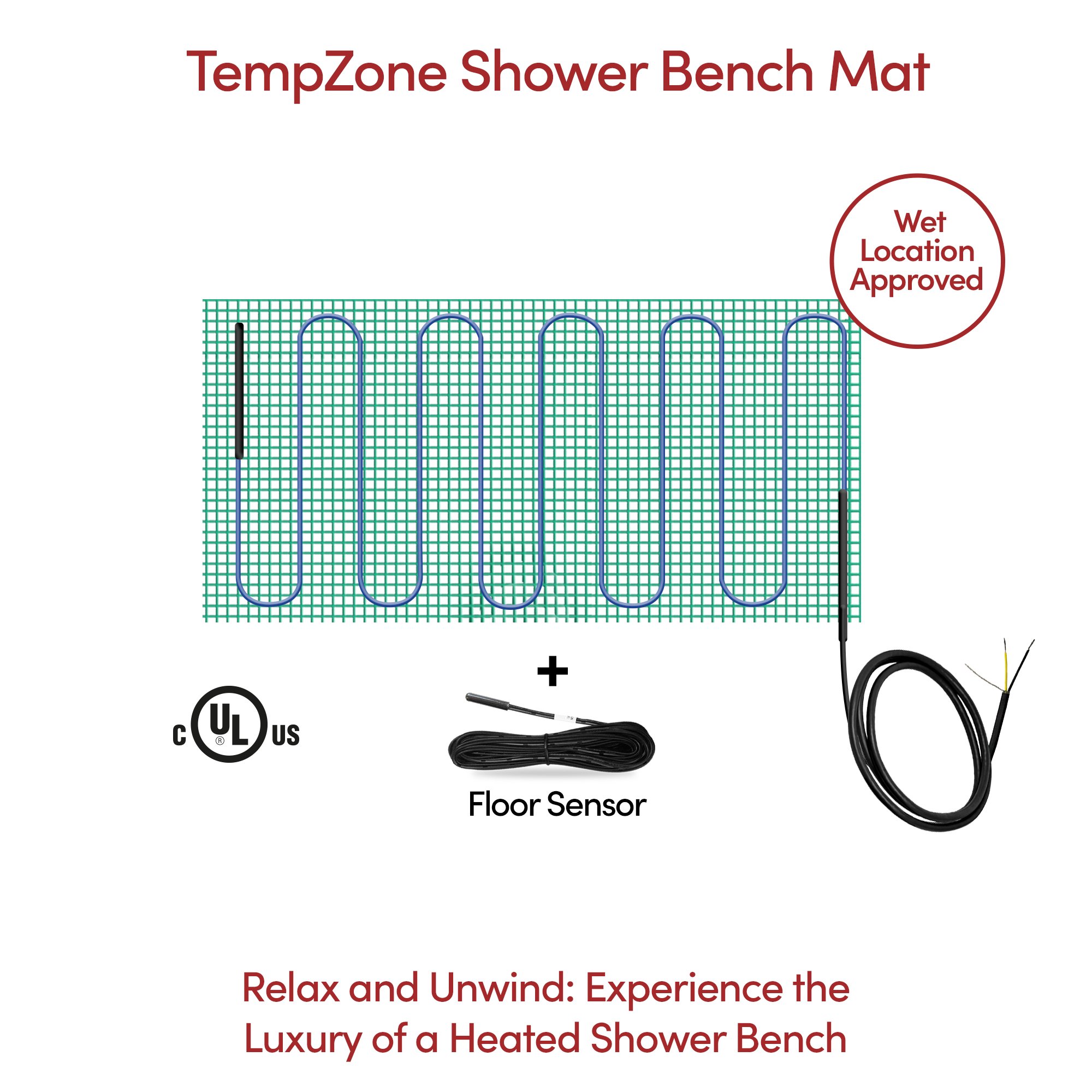
In This Article
Wet rooms and curbless showers are two of the most sought-after bathroom renovations today. Driven by a desire for open-concept living and universal design, homeowners are increasingly opting for these stylish and functional upgrades. This guide will walk you through the differences between wet rooms and curbless showers, the best flooring options for each, and how to incorporate the luxury of radiant floor heating.
What is a Wet Room?
A wet room is a fully waterproofed bathroom where the shower is open or set behind a simple glass screen. The entire room is designed to handle water, with a slight gradient in the floor to guide water to a drain. This design often includes a freestanding bathtub within the same open, waterproofed area.
Pros of a Wet Room
- Luxurious, Spa-Like Feel
- Maximizes Space
- Accessibility (Universal Design)
- Easy to Clean
- Increases Home Value
Cons of a Wet Room
- Higher Installation Costs
- Water Can Spread
- Can Feel Cold
- Requires Excellent Ventilation
What is a Curbless Shower?
A curbless shower, also known as a walk-in shower, is a shower that has no curb or threshold. It provides a seamless transition from the bathroom floor to the shower. Unlike a wet room, a curbless shower is typically enclosed with glass panels to contain water.

Pros of a Curbless Shower
- Modern, Clean Aesthetic
- Enhanced Accessibility
- Easier Maintenance
- Design Flexibility
Cons of a Curbless Shower
- Complex Installation for Drainage
- More Costly than Traditional Showers
Wet Room vs. Curbless Shower: At a Glance
| Feature | Wet Room | Curbless Shower |
|---|---|---|
| Waterproofing | Entire room is waterproofed. | Shower area is waterproofed, with a seamless transition to the main bathroom floor. |
| Enclosure | Open or with a minimal glass panel. | Typically enclosed with glass walls and a door. |
| Cost | Generally more expensive due to extensive waterproofing. | More affordable than a wet room, but more expensive than a traditional shower. |
The Perfect Flooring for Your Modern Bathroom
Choosing the right flooring is crucial for both safety and style. Here's a look at the best options:
For Wet Rooms
Vinyl Sheet
Best choice. Installed in a single, seamless piece across the entire floor, there are no joints or gaps for water to penetrate.
Concrete
A durable and stylish option that can be stained or stamped to match any decor. When properly sealed, it's highly water-resistant.
Tile
Smaller tiles, like mosaics, provide more grout lines for better slip resistance. Porcelain tiles are incredibly durable and water-resistant.
For Curbless Showers
Porcelain Tile
The most popular choice for its durability, water resistance, and low maintenance.
Ceramic Tile
A budget-friendly alternative to porcelain that still offers excellent water resistance.
Natural Stone
For a touch of luxury, consider marble, limestone, or granite. Keep in mind that natural stone requires more maintenance and sealing.
Video Guide: Waterproofing a Curbless Shower
Struggling with cold bathrooms and worried about water damage? This step-by-step video demonstrates how to properly install a waterproof, heated flooring system in a curbless shower, transforming your bathroom into a warm, comfortable, and moisture-free space.
This guide covers:
✅ An introduction to combining the Prodeso heat membrane and heating cable.
✅ Insight into the benefits of a curbless shower for aesthetics and accessibility.
✅ The detailed process of waterproofing using Prodeso membranes and Proband tape.
✅ An explanation of pre-fitted corners for maximum moisture protection.
✅ A step-by-step walkthrough of the entire installation process.
Don't Forget the Warmth: Radiant Floor Heating
A bathroom remodel is the perfect time to add the luxurious comfort of electric floor heating. It provides silent, energy-efficient warmth right under your feet.

Why Choose Heated Floors?
Extend Warmth Directly Into Your Shower
The comfort of radiant heat isn't limited to the bathroom floor. Many of our TempZone™ Floor Heating products are UL Listed and approved for wet locations, allowing you to bring that same luxurious warmth safely into your shower enclosure for the ultimate spa-like experience.
TempZone™ Shower Floor Mats
Ensure your first step into the shower is a warm one. These mats are engineered for traditional shower floors, featuring a wire-free drain area for easy installation under tile and stone. Generating 15 watts per sq. ft., they are backed by a 25-year No Nonsense™ Warranty.

TempZone™ Shower Bench Mats
Add gentle warmth and comfort to your shower bench to create a true spa experience at home. Safe for wet locations, these mats produce 15 watts per sq. ft. and are fully backed by our 25-year No Nonsense™ Warranty covering parts and labor.

Explore All Floor Heating Solutions
From rolls and mats for large rooms to free-form cables for custom layouts, the TempZone™ line has a solution for every project, ensuring you find the perfect fit for your unique needs.
Frequently Asked Questions (FAQ)
How do you make a small bathroom look bigger?
Both wet rooms and curbless showers are excellent for making a small bathroom feel more spacious. Other tips include using a light color palette, installing large mirrors, opting for wall-mounted (floating) vanities, using a clear glass shower screen, and incorporating good lighting.
Are wet rooms a good idea?
Yes, wet rooms can be a fantastic addition to your home, especially if you're looking for a modern, accessible, and luxurious bathroom. However, they require professional installation and proper ventilation to avoid any potential issues with moisture.
How much does a wet room cost?
A wet room typically costs 20-30% more than a traditional bathroom renovation. This is mainly due to the extensive waterproofing (tanking) required to protect the entire room.
Ready to start planning your dream bathroom?
Use the WarmlyYours Radiant Floor Heating Quote Builder to get an instant quote for adding heated floors to your project.
Get My Instant QuoteHave Questions About Your Project?
Our team of Radiant Experts is ready to help!
Comments
Stay Updated
Get the latest radiant heating news and tips delivered to your inbox.




Really an article pushing installing in floor heating.
Thanks for reading! Our expertise is in floor heating so naturally a lot of our articles are written from that perspective. And while we hope we're not being too pushy, we'll always be here if you ever need floor heating.